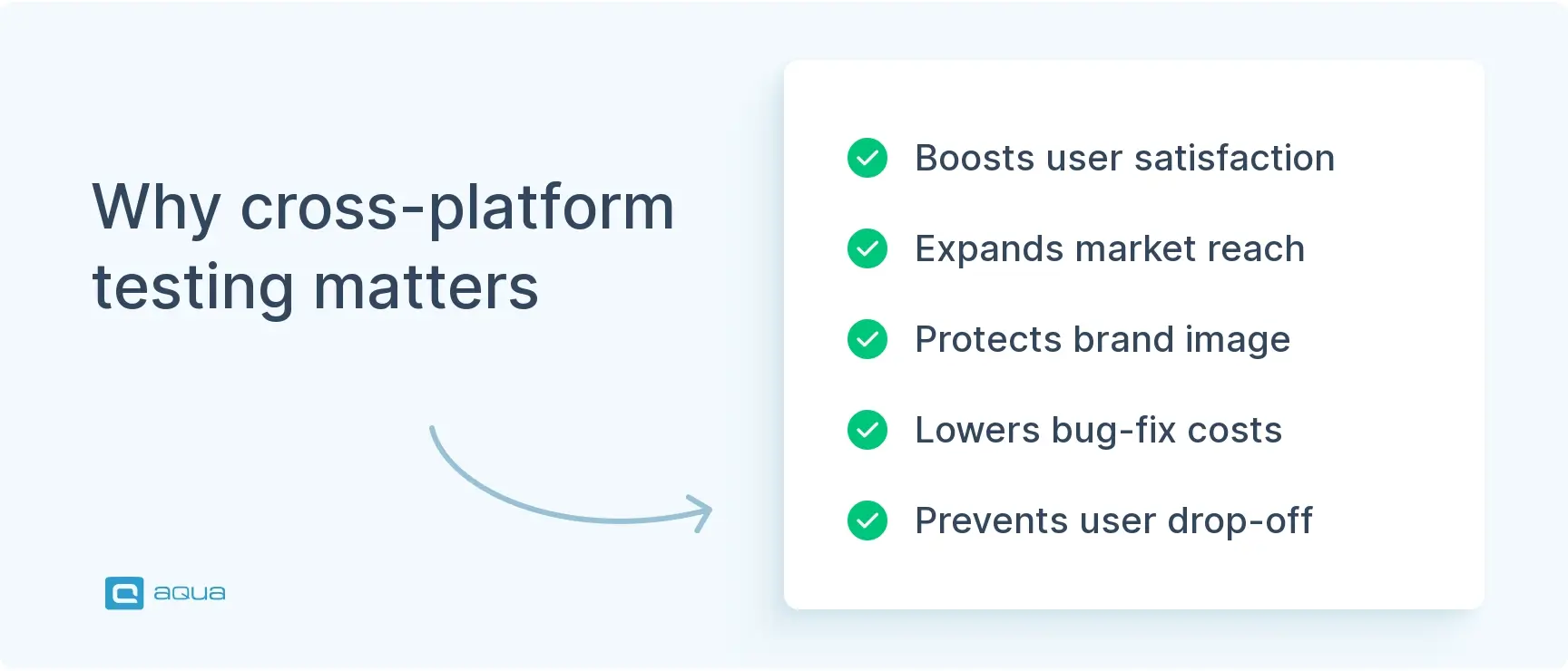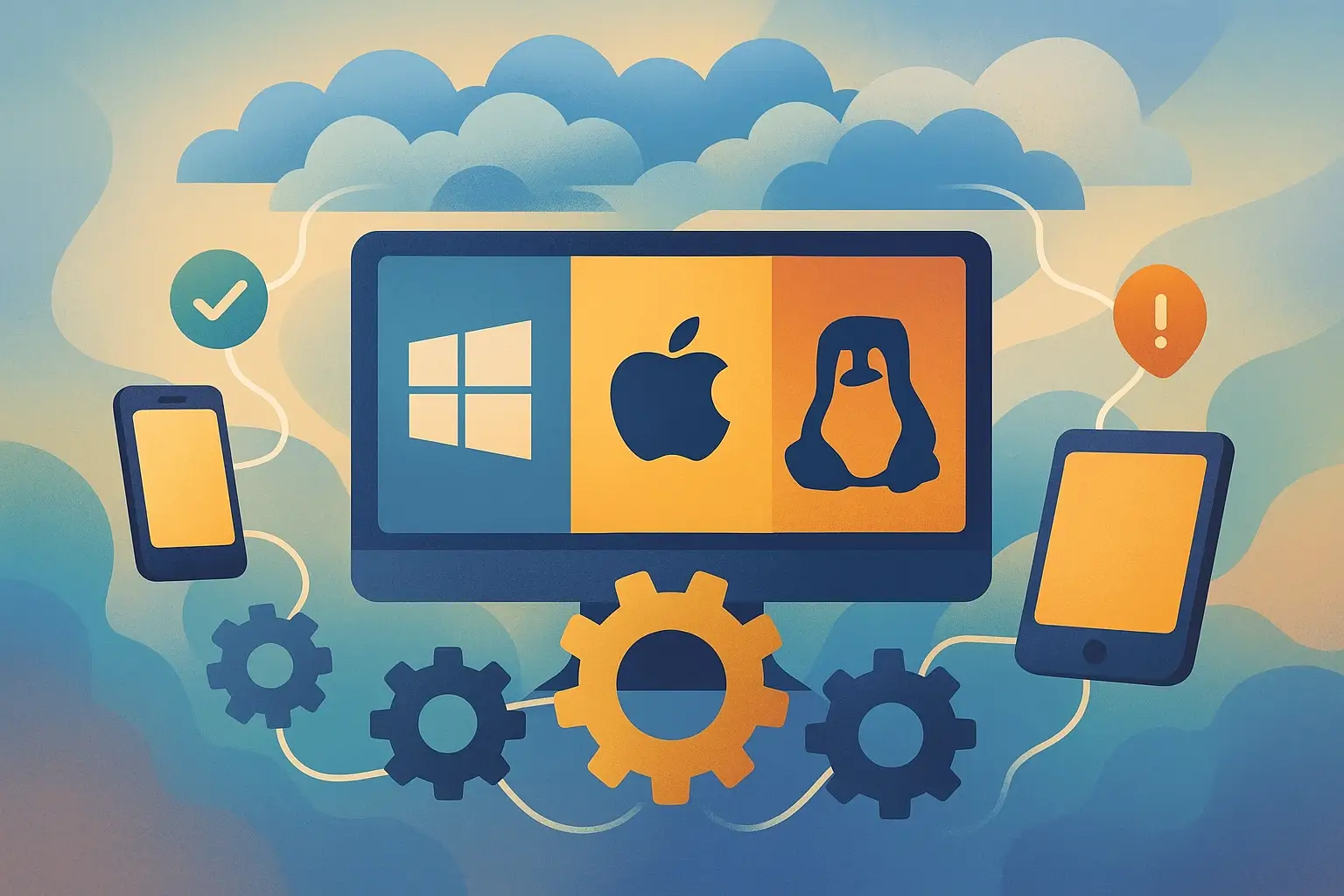What is Cross-Platform Testing?
Cross-platform testing is the process of verifying that your software applications work consistently across different operating systems, browsers, and devices. It ensures users get the same high-quality experience whether they’re using your product on an iPhone, Android, Windows PC, Mac, or browsing your website via Chrome, Firefox, Safari, or Edge.
Basically, you are confirming that all features function correctly, the user interface looks good, and performance meets expectations across every platform your users might choose.
Cross-platform testing typically involves:
- Functional testing: Does every feature work as expected on each platform?
- Visual testing: Does the UI display correctly on different screen sizes and resolutions?
- Performance testing: Is the app responsive and quick on all supported platforms?
- Compatibility testing: Does the app interact properly with other software on each platform?
The goal is to catch platform-specific bugs before users do, ensuring a seamless experience regardless of their device preferences.
Why is cross-platform testing important?
Cross-platform testing directly impacts your business success. Here’s why it matters:
Market Reach and Revenue Impact
- 57% of total daily internet usage now occurs on mobile devices, with 43.2% on computers
- The average household contains approximately 21 connected devices
- By ensuring your application works across platforms, you dramatically expand your potential user base
User Experience and Retention
- 76% of consumers use multiple channels during their decision-making process
- Users who encounter platform-specific issues are likely to abandon your product
- A single bad experience on one platform can permanently damage a user’s perception of your brand
Cost Savings
- Finding bugs early through systematic cross-platform testing costs significantly less than fixing them after release
- Emergency fixes for critical platform-specific issues discovered post-launch can disrupt development schedules and drain resources
So with cross-platform testing, you are protecting your brand reputation, maximising your market potential, and delivering the consistent experience users demand across all their devices.

To achieve maximum efficiency in your cross-browser testing efforts (and your overall test management efforts), you need an all-around Test Management System.
Because cross-browser testing can quickly turn into a chaos of duplicated test cases, manual tracking, and missed edge cases, especially when you’re trying to maintain consistency across dozens of browser combinations. That’s where aqua cloud steps in. It gives you two smart ways to stay in control: first, you can use custom fields to assign browsers to specific test cases for clear visibility and better defect tracking. Or you can manage everything in one place with dynamic value sets that run the same test across multiple browsers without duplication. Whichever approach fits your style, aqua helps you test faster, stay organised, and keep your team aligned—no spreadsheets or headaches required. That’s not it: aqua’s AI helps you create requirements, test cases and test data within 3 clicks while delivering 100% test coverage, traceability, and visibility. Test automation and project management integrations like Jira, Azure DevOps, Selenium and Jenkins are the cherries on top.
Master cross-browser testing with 100% AI powered TMS
What is Cross-Platform End-to-End Testing
Cross-platform end-to-end testing takes your cross-platform testing a step further by validating complete user workflows across different platforms. While basic cross-platform testing might focus on individual features or screens, end-to-end testing examines the entire user journey from start to finish.
For example, an e-commerce end-to-end test might verify that a user can:
- Browse products on their desktop
- Add items to cart on their mobile phone
- Complete checkout on their tablet
It ensures that individual components work across platforms and the entire user experience flows seamlessly regardless of which devices your users switch between.
Key aspects of cross-platform end-to-end testing include:
- Multi-device user journeys: Validating complete workflows across device transitions
- Data persistence: Ensuring user data follows them across platforms
- Platform-specific integration points: Testing how the application interacts with platform-specific APIs and features
- Performance consistency: Verifying comparable speed and responsiveness throughout the flow on all platforms
Effective cross-platform end-to-end testing requires specialised tools and strategies to simulate realistic multi-device usage patterns and find issues that you might only see during platform transitions.
Role of Cross-Platform Testing on User Experience
Cross-platform testing plays a critical role in delivering the cohesive, friction-free experiences users expect today. Here’s how it directly impacts user experience:
Consistency Builds Trust: When your app behaves predictably across platforms, users develop confidence in your product. They don’t have to relearn how to use features when switching devices, which reduces cognitive load and frustration. This consistency builds trust in your brand.
Smooth Multi-Device Journeys: Today’s users don’t just use one device – they constantly switch between phone, tablet, laptop, and more. Cross-platform testing ensures these transitions feel natural and seamless. A user who starts a task on their phone should be able to continue it on their desktop without confusion or data loss.
Preventing Platform-Specific Frustrations: Nothing damages user satisfaction faster than discovering a feature works on one platform but not another. Cross-platform testing identifies these discrepancies before users encounter them, preventing the “it works on everything except my device” complaints that lead to negative reviews and abandonment.
Performance Expectations Across Environments: Users expect responsive performance regardless of platform. Cross-platform testing helps identify when an application might run smoothly on high-end devices but struggle on others, allowing you to optimise accordingly.
How to create a cross-platform testing plan step-by-step?
Creating an effective cross-platform test plan requires careful planning and prioritisation. Follow these steps to build a comprehensive strategy:
1. Research Your User Base
- Analyse your analytics data to identify which platforms your users actually use
- Create a prioritised list of operating systems, browsers, and devices based on user adoption
- Consider geographical variations in platform popularity if you have a global audience
2. Create a Test Matrix
- Build a spreadsheet mapping test scenarios against platforms
- Include columns for device types, OS versions, browsers, and screen resolutions
- Assign priority levels to each combination based on user data
Here is an example of this matrix:
| Platform / OS | Chrome | Firefox | Safari | Edge | Mobile Chrome | Mobile Safari |
|---|---|---|---|---|---|---|
| Windows 11 | ✅ | ✅ | ❌ | ✅ | ❌ | ❌ |
| Windows 10 | ✅ | ✅ | ❌ | ✅ | ❌ | ❌ |
| macOS (Sonoma) | ✅ | ✅ | ✅ | ✅ | ❌ | ❌ |
| macOS (Monterey) | ✅ | ✅ | ✅ | ✅ | ❌ | ❌ |
| iOS 17 (iPhone) | ❌ | ❌ | ❌ | ❌ | ❌ | ✅ |
| Android 13 | ❌ | ❌ | ❌ | ❌ | ✅ | ❌ |
| iPadOS 17 | ❌ | ❌ | ❌ | ❌ | ✅ | ✅ |
| Linux (Ubuntu 22) | ✅ | ✅ | ❌ | ❌ | ❌ | ❌ |
Here’s another example of a cross-browser and cross-platform test matrix, used to ensure that key user flows work consistently across different devices, OS, browsers, and screen resolutions:
| Test Scenario | Device Type | OS Version | Browser | Screen Resolution | Priority |
|---|---|---|---|---|---|
| Login with valid credentials | Desktop | Windows 11 | Chrome 124 | 1920×1080 | High |
| Login with valid credentials | Desktop | macOS Sonoma | Safari 17 | 2560×1600 | Medium |
| Login with valid credentials | Mobile | iOS 17 | Safari | 390×844 | High |
| Login with valid credentials | Mobile | Android 14 | Chrome | 412×915 | High |
| Add item to cart | Desktop | Windows 10 | Firefox 126 | 1366×768 | Medium |
| Add item to cart | Tablet | Android 13 | Chrome | 800×1280 | Low |
| Checkout process | Desktop | Windows 11 | Edge 124 | 1920×1080 | High |
| Checkout process | Mobile | iOS 17 | Safari | 390×844 | High |
| Checkout process | Desktop | Ubuntu 22.04 | Chrome | 1920×1080 | Low |
3. Define Test Scenarios
- Create platform-agnostic test cases that verify core functionality
- Add platform-specific tests for features that use native capabilities
- Include edge cases that might behave differently across platforms
4. Choose Testing Approaches
- Determine which tests will be manual vs. automated
- Select appropriate testing tools for each platform combination
- Consider cloud-based testing services for broad device coverage
5. Establish Testing Environments
- Set up testing infrastructure for each target platform
- Create standardized test data sets that work across all environments
- Document environment configuration details for consistency
6. Define Bug Severity Guidelines
- Create platform-specific criteria for bug severity classification
- Establish which platform-specific issues are release blockers
- Set thresholds for acceptable platform variations
7. Schedule Testing Cycles
- Integrate cross-platform testing into your development lifecycle
- Allow sufficient time for testing across all priority platforms
- Plan for regression testing after platform-specific fixes
8. Create Reporting Templates
- Design standardised bug reports that clearly indicate platform specifics
- Develop dashboards to track cross-platform quality metrics
- Establish communication channels for platform-specific issues
9. Plan for Continuous Improvement
- Schedule regular reviews of your platform coverage
- Update your test matrix as platform usage patterns change
- Document platform-specific learnings for future reference
Follow these steps and you’ll create a structured approach to cross-platform testing that focuses your resources where they’ll have the greatest impact on user experience.
Process of Cross-Platform Testing (Simplified)
Cross-platform testing usually follows a clear process. After you’ve set up your test environments and written your test cases, it’s time to run the tests. This is when you start noticing differences between platforms—like performance issues, bugs, or layout problems. To make testing smooth and effective, follow this practical approach:
Prioritise Test Execution
Start testing on your main platform first (usually the most used or most stable one). If everything works there, move on to other platforms in order of importance. This helps you avoid wasting time on platform-specific bugs before confirming that your tests work in general.
Best Practices for Effective Testing
- Run tests in parallel: Use tools like device farms or virtual machines to test on multiple platforms at once. This saves time and helps you catch issues early.
- Consider screen size and layout: Make sure your app looks and works well on different screen sizes and resolutions—from desktops to mobile phones.
- Handle dynamic elements: Be ready for changes in layout or behaviour across platforms, like how a website might behave differently on different browsers or operating systems.
- Check fallback behaviour: Test how your app handles missing features, like what happens if a device doesn’t support a certain animation or permission.
- Capture everything: Save logs, screenshots, and videos during your tests. They’ll help you figure out what went wrong when a problem only shows up on one platform.
- Test under real conditions: Try your app with slow internet or low battery to see how it performs in less-than-ideal situations, especially on mobile.
- Cover older versions too: Don’t just test on the latest OS or browser. Include older versions that real users still rely on, especially on Android and desktop.
Understanding Test Results
You’ll find differences between platforms, but not all of them are bugs. Learn to tell the difference between:
- Real bugs – like when a form doesn’t work in Firefox
- Minor differences – like fonts looking slightly different
- Known platform limits – like a feature that just isn’t supported on older iPhones
Labelling each issue correctly helps your team fix real problems faster.
Manual vs Automation Cross-Platform Testing
Choosing between manual and automated testing approaches for cross-platform projects requires understanding the strengths and limitations of each. Here’s a comparison to help you determine the right strategy:
| Aspect | Manual Testing | Automated Testing |
|---|---|---|
| Best For | Exploratory testing, usability evaluation, and complex scenarios requiring human judgment | Repetitive tests, regression testing, and parallel execution across multiple platforms |
| Accuracy | Subject to human error, especially with repetitive tasks | Highly accurate for predictable scenarios, but may miss context-dependent issues |
| Speed | Slower, especially when testing across many platforms | Much faster for repeated execution, allows parallel testing |
| Cost | Higher ongoing labor costs, lower initial investment | Higher upfront investment, lower long-term costs |
| Platform Coverage | Limited by available testers and devices | Can scale to cover many platform combinations simultaneously |
| User Experience Insights | Provides valuable subjective feedback on feel and usability | Limited to programmatically verifiable criteria |
| Setup Complexity | Minimal setup required to begin testing | Requires significant initial setup and maintenance |
| Adaptability | Easily adapts to changing requirements | May require script updates when the application changes |
| CI/CD Integration | Difficult to integrate into automated pipelines | Seamlessly integrates with CI/CD processes |
When to Use Manual Testing
- During early development when the UI changes frequently
- For exploratory testing to discover unexpected platform behaviors
- When evaluating subjective qualities like usability and aesthetic consistency
- For one-time compatibility checks on less common platforms
- When testing complex user journeys that rely on real-world conditions
When to Use Automated Testing
- For regression testing after code changes
- When testing the same functionality across many platform combinations
- For performance testing under various device conditions
- When integrating testing into CI/CD pipelines
- For high-frequency test execution during rapid development cycles
Hybrid Approach Benefits
Many successful QA teams use a hybrid approach, combining:
- Automated tests for core functionality across all platforms
- Manual exploratory testing to catch platform-specific edge cases
- Automated visual testing for UI consistency with manual review of flagged differences
- Manual evaluation of subjective quality aspects with automated verification of objective criteria
The ideal balance depends on your specific application, team resources, and release cadence. As a general rule, the more platforms you need to support, the more automation becomes necessary for sustainable testing practices.
Carry out cross-browser testing, especially for consumer-facing UIs. We have found plenty of browser compatibility issues. Safari and Firefox private modes, for example, behave totally differently from Chrome's for cross-origin requests.
Best tools for Cross-Platform Testing
The right tools can dramatically improve your cross-platform testing efficiency. Here’s a breakdown of top tools in different categories:
Cloud-Based Testing Platforms
BrowserStack
- Access to 3,000+ real devices and browsers
- Live interactive testing and automated Selenium tests
- AI-powered visual testing capabilities
- CI/CD integration with major pipelines
- Perfect for teams needing broad real-device testing without hardware investment
BrowserStack is not a framework rather a testing platform where you can integrate different frameworks. Apart from that, BrowserStack is the go-to choice for cross-browser or cross-platform testing. I have tried a bunch of tools in the past, but only they seem to have the updated versions of browsers/devices.
LambdaTest
- 3,000+ browser-device combinations
- Parallel testing for faster execution
- Integrated screenshot and video recording
- Visual comparison tools for UI testing
- Excellent for teams with high-volume testing requirements
Sauce Labs
- 800+ browser and device combinations
- Comprehensive analytics dashboards
- Strong security features for enterprise compliance
- Real device cloud and emulator options
- Well-suited for enterprise-level testing needs
Automation Frameworks
Selenium WebDriver
- Open-source cross-browser testing
- Supports multiple programming languages
- Extensive community support
- Detailed control over test execution
- Best for web app testing with experienced automation engineers
Appium
- Open-source mobile automation framework
- Uses the same API for ios and Android
- Supports native, hybrid, and mobile web apps
- No modification of app code required
- Ideal for teams testing mobile applications across platforms
Visual Testing Tools
Applitools
- AI-powered visual testing
- Automatic detection of visual bugs
- Cross-browser and responsive design testing
- Root cause analysis tools
- Excellent for visually complex applications
CrossBrowserTesting
- Visual comparison across browsers
- Screenshot testing across multiple devices
- Live testing capabilities
- Integration with popular development tools
- Good all-around solution for visual consistency checks
Cross-Platform Testing Challenges
Cross-platform testing comes with unique challenges that can complicate your QA efforts. Understanding these challenges is the first step toward addressing them effectively:
Device and OS Fragmentation
- Challenge: The vast number of device-OS-browser combinations makes comprehensive testing impractical
- Solution: Use analytics to identify and prioritise the most common combinations used by your audience
- Tip: Focus on representative devices from each category rather than trying to test every possible combination
Platform-Specific Behaviors
- Challenge: Features may work differently across platforms due to underlying OS capabilities
- Solution: Create platform-specific test cases that account for expected differences
- Tip: Document acceptable variations vs. actual defects to avoid false bug reports
Test Environment Management
- Challenge: Maintaining up-to-date test environments for multiple platforms is resource-intensive
- Solution: Use cloud-based testing platforms to access a wide range of pre-configured environments
- Tip: Create a regular schedule for updating test environments as new OS versions are released
Performance Variability
- Challenge: Performance metrics can vary dramatically across different hardware capabilities
- Solution: Establish platform-specific performance baselines and thresholds
- Tip: Test on both high-end and low-end devices within each platform category
UI Rendering Differences
- Challenge: Visual elements may render differently across browsers and devices
- Solution: Implement visual testing tools that can detect rendering discrepancies
- Tip: Define acceptable visual variation thresholds to focus on meaningful differences
Automation Complexity
- Challenge: Creating and maintaining automation scripts that work across platforms requires significant effort
- Solution: Use cross-platform testing frameworks that abstract platform differences
- Tip: Start with a core set of tests that run everywhere, then add platform-specific test extensions
Tool Limitations
- Challenge: No single tool works perfectly across all platforms and testing types
- Solution: Adopt a toolchain approach, selecting the best tool for each platform/testing need
- Tip: Evaluate tools based on your specific platform priorities rather than general reviews
Continuous Platform Evolution
- Challenge: Platforms constantly update, potentially breaking existing functionality
- Solution: Implement monitoring for new platform releases and schedule compatibility testing
- Tip: Join beta testing programs for major platforms to test your application before public releases
These challenges are exactly why cross-platform testing often becomes more complicated than it needs to be. From coordinating test runs across browsers to tracking results without losing your mind, it’s easy for teams to get buried in manual work and messy documentation.
That’s where aqua cloud makes a real difference. Instead of relying on spreadsheets or duplicated test cases, aqua gives you flexible options to streamline cross-browser testing from start to finish. You have all the freedom: you can assign specific browsers to test cases using custom fields for clear visibility and seamless defect reporting. Or, if you prefer a more compact setup, use value sets to run the same test across multiple browsers without ever duplicating a thing. aqua handles the heavy lifting—executing, tracking, and managing tests across platforms—so your team can focus on what actually matters: delivering consistent, reliable experiences for every user.
Speed up your cross-browser testing efforts 2x with AI-powered TMS
Best Practices for Cross-Platform Testing
Implementing these best practices will help your team deliver more consistent experiences across platforms:
1. Start testing early in the development cycle
- Don’t wait until the end to check cross-platform compatibility
- Include platform testing in your definition of “done” for each feature
- Consider platform requirements during design phases
2. Use a tiered testing approach
- Tier 1: Run smoke tests across all supported platforms
- Tier 2: Conduct deep testing on most common platform combinations
- Tier 3: Perform specialized testing for high-risk platform-specific features
3. Implement continuous testing
- Integrate automated cross-platform tests into CI/CD pipelines
- Set up nightly test runs across expanded platform combinations
- Configure alerts for platform-specific test failures
4. Measure the right metrics
- Track test coverage by platform
- Monitor platform-specific defect rates
- Measure platform performance comparatively
5. Balance emulators and real devices
- Use emulators for rapid initial testing
- Verify findings on real devices before release
- Include both latest and older device models in your testing mix
6. Combine manual and automated approaches
- Automate repetitive compatibility checks
- Use exploratory manual testing for platform-specific edge cases
- Apply human judgment to subjective aspects of user experience
7. Document platform-specific exceptions
- Create a knowledge base of acceptable platform differences
- Document workarounds for unavoidable platform limitations
- Share platform insights across development teams
8. Implement visual regression testing
- Use automated tools to catch unexpected UI changes
- Define acceptable visual difference thresholds by platform
- Maintain visual reference libraries for UI components
9. Consider performance testing across platforms
- Establish performance benchmarks for each supported platform
- Test under various network conditions relevant to each platform
- Monitor platform-specific performance metrics from real users
10. Maintain platform-specific test data
- Create test data sets that exercise platform-specific features
- Consider differences in data handling across platforms
- Test with realistic data volumes for each platform type
11. Review analytics regularly
- Adjust platform testing priorities based on changing usage patterns
- Track platform-specific user behaviors and pain points
- Use real-world data to focus testing efforts
By incorporating these best practices into your testing strategy, you’ll build more robust applications that deliver consistent quality regardless of the platform your users choose.
Conclusion
Cross-platform testing is all about delivering on the promise you make to users that your product will work seamlessly wherever and however they choose to use it. Remember that it is an ongoing journey, not a one-time project. Platforms evolve, user preferences shift, and new devices emerge regularly. The teams that build effective cross-platform testing into their development culture, rather than treating it as an afterthought, are the ones that will continue to delight users across all platforms.


















